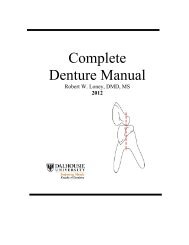RPD Manual 11 - Removable Prosthodontics - Dalhousie University
RPD Manual 11 - Removable Prosthodontics - Dalhousie University
RPD Manual 11 - Removable Prosthodontics - Dalhousie University
Create successful ePaper yourself
Turn your PDF publications into a flip-book with our unique Google optimized e-Paper software.
Summary of Design Principles for <strong>Removable</strong> Partial Dentures<br />
General Principles<br />
- Minimize framework elements (minimize minor connectors, plating, etc.) – more hygienic<br />
Principles of Partial Denture Design - 69<br />
- Obtain good base adaptation - better stress distribution; use altered cast for mand. distal extensions<br />
- Use what is present (e.g. existing rest seats)<br />
- Plan for the future (e.g. designing for continued use of <strong>RPD</strong> framework if a critical abutment is lost; placing<br />
rest seats, guide planes and undercuts on crowns to allow fabrication of an <strong>RPD</strong> later)<br />
- Never plan an <strong>RPD</strong> using a single cast alone. You can’t assess abutment mobility, compressibility of mucosa,<br />
the level of the floor of the mouth, prominent frena, or occlusion. Use mounted models and assess these<br />
features intraorally as you plan and check your design.<br />
- Occlusion – AVOID:<br />
o centric contacts on rests (also ensure no increase in OVD)<br />
o heavy buccal contacts on denture teeth– causes more movement of removable partial denture<br />
- When other dental treatment is planned, and an <strong>RPD</strong> will be made at the end of treatment – ALWAYS PLAN<br />
THE <strong>RPD</strong> FIRST. You will see which abutment modifications will be needed, and will ensure the planned<br />
<strong>RPD</strong> is feasible, prior to beginning treatment<br />
Rest Seats/ Rests<br />
Ensure sufficient depth, especially at junction of the rest & minor connector (1.5mm minimum)<br />
Tooth Borne (Kennedy Class I & II) – place rests adjacent to edentulous space (both ends)<br />
Tissue/Tooth Borne (Kennedy Class I & II)<br />
- mesial rest preferred (less torquing of abutment)<br />
- distal rest preferred when:<br />
- abutment is rotated (limited access for minor connector to mesial)<br />
- plunger cusp/heavy centric contact on mesial<br />
- large restoration on mesial<br />
- no long guiding planes with distal rests - potential torquing<br />
- if tooth is severely weakened periodontally – sometimes move rest to the next tooth anterior<br />
Incisal rests/rest seats<br />
- don’t use - poor esthetics<br />
- more tilting/torquing forces (long lever arm from center of rotation)<br />
Cingulum rests/rest seats<br />
- use composite build up, if no prominent cingulum (less dentinal sensitivity)<br />
- size - min 1 mm (if deeper, chance of dentin exposure)<br />
- ensure sufficient clearance from opposing occlusion for maxillary cingulum rests<br />
Occlusal rests/rest seats<br />
- size - 1/3 of B-L width of the tooth<br />
- depth : 1.5 mm of clearance from opposing occlusion (critical at junction of rest & minor connector)<br />
- line angle of the marginal ridge should be rounded<br />
- deepest part should be located centrally (positive)<br />
Indirect Retainers<br />
- 90° from fulcrum line & as far away from primary abutment as possible<br />
- none required on tooth borne (Cl III & IV) cases<br />
- canine is usually the most anterior tooth used for indirect retention<br />
- usually don’t use a lateral (root length) or central incisor (speech)<br />
- also helpful for seating and support, but not always possible or necessary















